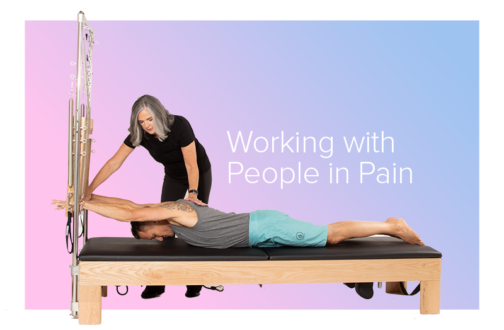Pain is fascinating! (I’m sure if you are in pain right now though, you don’t think it’s fascinating. You probably just want it to stop.)
Like many people, pain brought me to Pilates. 25-odd years ago, I was desperately looking for a solution to chronic back pain. When I was 22 (and a student), I had fairly major surgery on my spine for two prolapsed discs. For the 18 months prior to surgery, I’d been in agony. For someone so young, I felt like an old woman. I just couldn’t understand what was wrong.
When I recovered from the back operation, it seemed to have been a miracle cure. I was pain-free and was able to return to racing, sailing dinghys, skiing, cycling— all the things I loved. But! 5 years later, my back problems returned tenfold. I lost power and feeling in my left foot, had no reflex in my right ankle, and it felt like a spear had been thrust through my left calf. I couldn’t work, in fact, I couldn’t do anything. I was advised to have a second operation, but this time there was a risk of permanent damage and even paralysis. I was terrified.
After a long road, I eventually found Pilates and my journey back to health began. Learning to move well and build strength was vital, but that was only half the solution. Learning about pain was the other half.
What is the purpose of pain? What is your brain trying to tell you when you feel pain?
Pain is the most powerful protective device the human organism has. It can literally stop you in your tracks. Think about twisting your ankle – how the pain makes you hobble and take the load of the damaged joint. Pain in this instance is protecting you from doing more harm to that ankle. Sometimes though, we feel pain long after tissues have healed, or even when we have done nothing to cause damage to tissues in the first place.
Pain science has changed the way we understand pain. For those of us working with people in pain, we may have to revise our own belief systems as well as those we teach Pilates to.
A common misconception is that pain originates in the tissues. You stand on a nail and the pain travels up to the brain. Actually, all pain is created in the brain. We don’t even have pain sensors or pain pathways. Rather, we scrutinize a diverse range of information by sampling our tissues – the world around us, thoughts, beliefs, even past experiences. Our brains weigh the world to decide if the pain is useful or not. We call this the bio-psycho-social model of pain, and it has replaced the old bio-medical model of pain.
Consider these examples where the pain experienced was wildly different to the level of tissue damage.
Professor Joanna Bourke researched pain in war settings. Many, war-wounded people have said that the initial sensation of being hit by a missile is similar to being struck with a stone or a lump of mud. Professor Bourke states, “My research uncovered one pilot who observed that being struck by a shard of shrapnel “felt like a prodding finger,” while another admitted that his only thought was “that’s funny … I’ve been wounded.” Other soldiers simply recalled that they felt nothing except intense relief. “I do believe I’m going to survive this war after all,” said one.
Contrarily, consider a smaller dose of pain. Who has had a paper cut? It’s not deep, there’s not much tissue damage, but it is so painful!
In low-back pain, research has shown that the amount of nerve and disc damage rarely relates to the amount of pain experienced. Jenson (1994) performed MRI scans on 98 asymptomatic people — meaning no pain or symptoms at all. Only 36% had normal discs at all levels. The other 64% had either disc bulges or abnormalities. Many showed degeneration. Remember these people had no pain whatsoever. His conclusion was that the discovery by MRI of bulges or protrusions in people with low-back pain may frequently be coincidental.
Pain is definitely a message—it grabs our attention. But if it’s not about how much damage we have done to tissue, what is the message? Why would someone with a horrific injury feel little or no pain while a minor paper cut hurts so much?
Pain is actually a measure of how threatened or safe our brain thinks we are. If our brains think our organism is under threat, it will generate pain to get us to do something about it. Pain is designed to protect.
Research has shown that learning about pain can actually reduce pain. Knowledge makes our brains feel safe. We are amazing bioplastic beings. Sometimes we learn to be over-protective, and an old injury can stay painful long after tissues have healed. The good news is that we can change and re-wire our brains to be less protective and to calm down an over-sensitive ‘danger alarm’ system.
As Pilates teachers, we can use movement to shift someone’s ‘protect by pain’ buffer back into a normal range. Using tools like graded movement and education can help people experience less pain and become more active. For Pilates teachers, learning about pain can give you confidence to know what is safe and not safe and how best to help people. Sharing pain education is transformative and can easily be peppered into a Pilates session.
The spine is incredibly strong, tissues heal, and muscles love to move. Our amazing brains are bioplastic, they learn and adapt. There is so much we can do to actively change people’s pain levels and ultimately move them towards a pain-free life.
Joseph Pilates said “Change happens through movement and movement heals.” Combine movement with pain education and that healing can be profound.
By Karen Ingram



